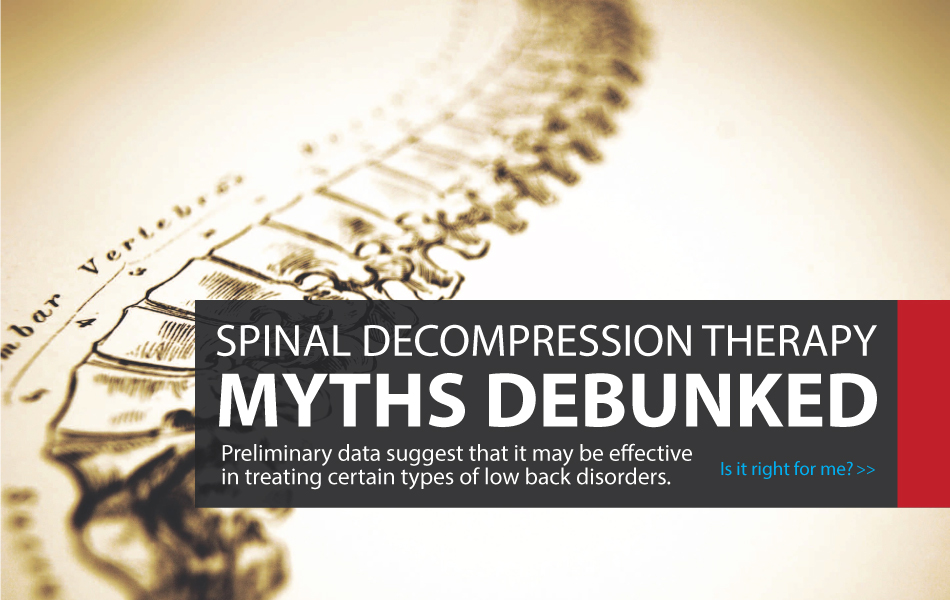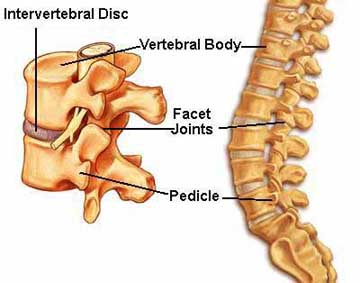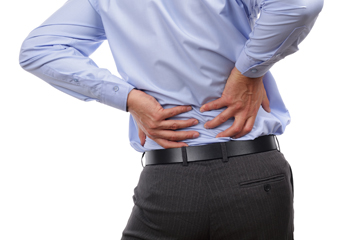Total Therapy Blog

Spine Decompression Therapy Myths Debunked
What is Spine Decompression Therapy?
Spine decompression therapy uses a gentle ‘pulling’ action through the spine to create an elongating effect. The goal of spine decompression therapy is usually targeted towards the spine’s discs, to create negative intradiscal pressure.
Why?
 According to supporters of spinal decompression therapy, creating negative intradiscal pressure has a number of positive effects on compressed discs. Discs are avascular in nature, meaning they don’t have a direct blood supply to bring nutrients and remove waste. Instead, discs rely on the diffusion to bring nutrients in and waste out to blood vessels nearby. If this process is inhibited, it can lead to accelerated disc degeneration and potential pain or loss of function.
According to supporters of spinal decompression therapy, creating negative intradiscal pressure has a number of positive effects on compressed discs. Discs are avascular in nature, meaning they don’t have a direct blood supply to bring nutrients and remove waste. Instead, discs rely on the diffusion to bring nutrients in and waste out to blood vessels nearby. If this process is inhibited, it can lead to accelerated disc degeneration and potential pain or loss of function.
Decompression may help discs by bringing in more nutrients as the negative pressure created draws in fluid. In addition, decompression may promote the retraction of bulging or herniated discs.
What the Evidence Says
Research into mechanical spine decompression therapy is still in its infancy. There is not enough evidence to definitively state that decompression therapy is as good or superior to other types of treatments. However, there is some preliminary data to suggest that it may be effective in treating certain types of low back disorders.
A study by Sherry et al. (2001) found that individuals with chronic low back pain who were randomized to receive spine decompression versus TENS experienced better outcomes. Specifically, the decompression group experienced greater decreases in pain and disability than the control TENS group, although the study’s sample was small (40 participants). Another study by Gose et al. (1998) looked at the use of decompression therapy for individuals with herniated or degenerated discs, or facet syndrome. They found a 71% success rate, with success being defined as pain decreasing to a 0 or 1 out of 5. Similarly, Gionis et al. reported in their 2003 study that 92% of participants experienced an improvement in their low back symptoms, although neither Gionis et al. nor Gose et al. had a non-treatment group to compare to.
The Bottom Line
 Spinal decompression therapy may be an effective way of treating certain low back disorders, such as chronic low back pain, degenerative or herniated discs, or facet issues. More research will enable us to better understand which patients stand to benefit the most. Spinal decompression therapy is not suitable for everyone. Pregnant women, people who’ve undergone spinal fusion with metallic rods, those with severe osteoporosis, unstable spondylolisthesis, compression fractures or certain bony defects of the spine are not appropriate candidates.
Spinal decompression therapy may be an effective way of treating certain low back disorders, such as chronic low back pain, degenerative or herniated discs, or facet issues. More research will enable us to better understand which patients stand to benefit the most. Spinal decompression therapy is not suitable for everyone. Pregnant women, people who’ve undergone spinal fusion with metallic rods, those with severe osteoporosis, unstable spondylolisthesis, compression fractures or certain bony defects of the spine are not appropriate candidates.
It’s important to speak with your physiotherapist or chiropractor to determine whether or not spinal decompression is right for you. Keep in mind, too, that spinal decompression may be more effective when used in conjunction with other types of therapy, such as a directed active rehabilitation program or hands-on manual treatment.
References:
Gionis, T; Groteke, E. Spinal decompression. Orthopedic Technology Review 2003, 5:36-9.
Gose, E; Naguszewski, W; Naguszewski, R. Vertebral axial decompression therapy for pain associated with herniated or degenerated discs or facet syndrome: An outcome study. J Neuro Research 1998, 20(4):186-90.
Sherry, E; Kitchener, P; Smart, R. A prospective randomized controlled study of VAX-D and TENS for the treatment of chronic low back pain. Neural Res 2001, 23:780-84.








Follow Us!
& Stay Up To Date
BLOG